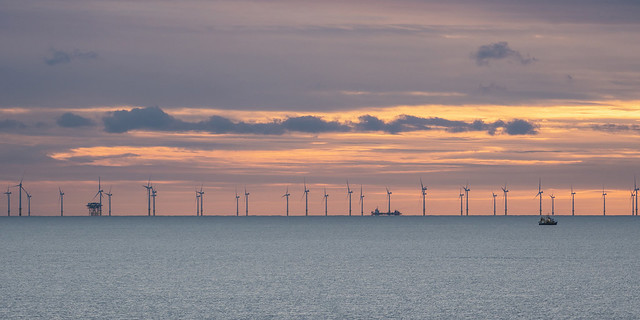We know what is needed in response to the climate challenges that we face.
The release of the IPCC Special Report on global warming of 1.5 degrees C (2.7 degrees F) last year urged us all to take rapid action on reducing greenhouse gas (GHG) emissions or face catastrophic changes in the climate. The upcoming IPCC Special Report on the Ocean and Cyrosphere in a Changing Climate is likely to double down on this message, focusing on the devastating impacts of climate change on the global ocean.
A new analysis, published today, reveals that the ocean is not just a victim of climate change, it is also a powerful source of solutions. Given political will, appropriate policy and investment in technology, the ocean could be a new ally in the fight.
Our report, “The Ocean as a Solution to Climate Change: Five Opportunities for Action,” was commissioned by the High Level Panel for a Sustainable Ocean Economy. It presents five areas of ocean-based climate action and offers detailed analysis of their potential to close the emissions gap in 2030 and 2050.
Implementing this wide array of ocean-based opportunities could reduce global GHG emissions by nearly 4 billion metric tonnes of carbon dioxide equivalent in 2030 and by more than 11 billion tonnes in 2050, compared to projected business-as-usual emissions. The emissions mitigated in 2050 are equivalent to the annual emissions from all of the world’s coal-fired power plants. While not a single silver bullet, this report concludes that oceans have a powerful role in stabilizing the earth’s climate again.
Figure 1: Contribution of Five Ocean-based Climate Action Areas to Mitigating Climate Change in 2050 (Maximum GtCO2e)

Ocean-based mitigation options could reduce the “emissions gap” (the difference between emissions expected if current trends and policies continue and emissions consistent with limiting global temperature increase) by up to 21 percent on a 1.5°C pathway, and by about 25 percent on a 2.0°C pathway, by 2050.
Figure 2: Contribution of Ocean-based Mitigation Options to Closing the Emissions Gap in 2050

The climate solutions explored in the report are:
- Ocean-based Renewable Energy
If ocean-based renewable energy technologies — such as offshore wind (using fixed and floating technology), wave, tidal and floating solar — displaced coal-fired power plants, the total mitigation potential for the sector could be equal to taking over 1 billion cars off the road per year.
Measures related to project finance and tax regimes will be crucial to promoting investment and support the deployment of offshore wind technologies. For other ocean-based renewable energy technologies, more policy support for research and development is needed to get the benefits of scale, including lower costs, that come with larger commercial plants.
- Ocean-based Transport
Ocean-based transport through international shipping has a powerful role to play. Technical and operational interventions are key to curbing energy consumption in international and domestic shipping and swapping low- and zero-carbon fuels (such as hydrogen, ammonia and some biofuels) for diesel and bunker oil.
The technology is ready now, but is being adopted in a limited way due to market barriers and market failures. Addressing these through national government and International Maritime Organization policy will be essential to reducing GHG emissions. There also needs to be development of supply chains and technologies to enable ships to switch to new low- and zero-carbon fuels.
- Coastal and Marine Ecosystems
Nature-based solutions including mangroves, salt marsh and seagrasses that store carbon, and seaweed aquaculture that can be used for fuel, food and feed, offer significant mitigation potential. They also help protect coastal areas from storms and act as nurseries for fish, increasing food security and biodiversity for local communities.
In the short term, we need to focus on conserving and protecting these valuable ecosystems to prevent the release of more of the carbon dioxide that is sequestered and stored in their soil. Restoration efforts must also be scaled up as well as research into the potential for seaweed to replace more emissions-intensive options for fuel, feed and food.
- Fisheries and Marine Aquaculture, and Dietary Shifts
Reducing emissions from optimizing wild fisheries, replacing feed in aquaculture and increasing the share of ocean-based protein in human diets, could also play a vital role.
Ocean-based proteins are far less carbon-intensive than land-based proteins (especially beef and lamb). Increasing their share in human diets will be essential to help the sector to achieve its mitigation potential. Sustainable growth in seafood production and consumption, particularly from aquaculture, is at the core of these potential benefits. Strategic policy will be required to increase the share of ocean-based food in the human diet.
- Carbon Storage in the Seabed
Storage of carbon in the seabed has enormous theoretical potential to divert carbon from the atmosphere, but it currently faces significant technical, economic and sociopolitical challenges – including concerns about environmental safety — that must be explored before this can be deployed at the necessary scale to realize its mitigation potential.
Additional Co-benefits Delivered by Ocean-Based Climate Action
In addition to emission reductions, ocean-based mitigation options will provide a host of related benefits, notably by providing synergy for countries working to achieve near-term sustainable development goals. Mitigation options were observed to have the strongest links with many of the economic and social sustainable development targets and indicators, implying that implementing these options in a sustainable manner would offer a range of opportunities. These opportunities include higher employment in ocean-based industries, gains from innovation, increase in revenues and profits to firms, improvement in livelihoods of local communities, better human health, contribution towards global food security targets, and the potential to ensure greater gender parity as ocean-based industries expand. Negative wider impacts on sustainable development should be investigated carefully. Detailed attention to policy development and project planning and implementation will be required to mitigate these impacts. This must be the responsibility of all involved stakeholders—governments, the private sector, researchers, project managers and local communities.
Across all the mitigation options, protection and restoration of mangroves, salt marshes and seagrasses has positive impacts across the largest number of sustainable development dimensions, and demonstrated the highest net positive score for its links with the Sustainable Development Goals (SDGs). The analysis also demonstrated that ocean-based mitigation options complement the land-based mitigation options in advancing the sustainable development agenda. Joint action in both these sectors will rapidly scale up the co-benefits observed across the sustainable development dimensions.
Figure 3: Summary of Wider Impact of Ocean-based interventions on Sustainable Development Dimensions

Countries have a few immediate opportunities to integrate these ocean-based climate solutions into national decision making and budgeting:
- Nationally Determined Contributions (NDCs): ocean-based option do not feature as prominently as they could in countries’ NDCs. Countries will be submitting new or updated NDCs in 2020 in an effect to close the emissions gap and align their efforts with the Paris Agreement. Inclusion of quantifiable targets, policies or measures aimed conserving and/or restoring blue carbon ecosystems (mangroves, salt marsh and seagrasses) and capturing their mitigation benefit in national GHG inventories offer impactful solutions for countries that also want to capitalize on the co-benefits associated with these ecosystems, such as protection from storms, increased biodiversity and marine life and job creation.
- Long-Term Strategies: long-term low greenhouse gas emission development strategies under the Paris Agreement offer an additional opportunity to ensure short-term decisions and priorities reflect a countries long-term goals for the decarbonization of their economy. Reflecting the opportunity for offshore renewable energy expansion and decarbonisation of ocean-based industries, such as transport, fisheries and aquaculture and ports, are ripe for inclusion in a countries long-term strategy.
- New “Sustainable Ocean Economy” Strategies: concepts of the “sustainable ocean economy” or “blue economy” are beginning to emerge as countries consider the use and management of their marine environments in a more holistic manner. These strategies must be approached through a climate and sustainability lens, not only to ensure resilience to climate impacts but to maximize opportunities for ocean-based activities to contribute positively to the fight against climate change.
This analysis offers new hope in the fight against climate change. Most options are ready to be implemented today and could offer many co-benefits in terms of creating jobs, improving air quality and human health, and supporting livelihoods. Bold political leadership and clear policy signals will be required to capitalize on the full potential of the solutions, coupled with strong national institutions and international cooperation to ensure their effective implementation.



